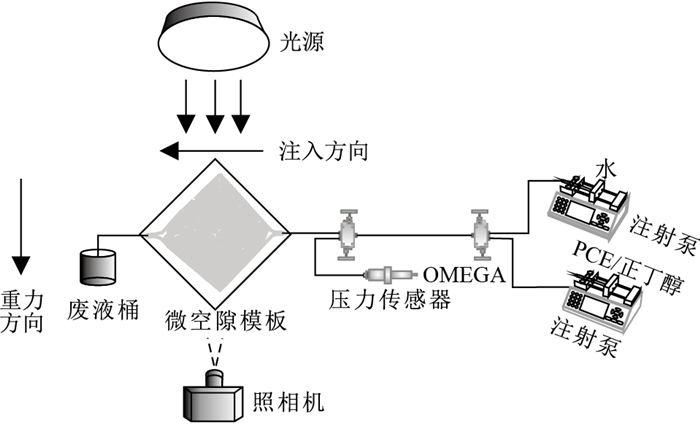Injecting n-BuOH to achieve density conversion of dense non-aqueous phase liquid: Pore-scale experimental simulation
-
摘要: 密度大于水的重非水液相(DNAPLs)有机污染物在重力作用下向地下介质深部迁移从而增加污染范围。前人通过一维砂柱和二维砂箱试验发现利用密度调节技术可降低DNAPLs向下迁移的风险,但目前缺乏微观尺度上密度调节影响DNAPLs迁移的定量观测。本研究试验模拟丁醇注入微空隙调节四氯乙烯(PCE)的密度,通过建立非水相中染色PCE浓度、密度与灰度的定量关系,监测注入丁醇后空隙介质中非水相密度的动态变化,基于空隙中代表性非水相PCE受力情况分析其运移状态,揭示空隙尺度介质性质和密度调节程度对DNAPLs迁移的影响。试验结果表明:丁醇注入后,PCE浓度和密度迅速下降,离散状PCE与丁醇有效接触面积大且起效快;当非水相密度降至略大于水相密度时,非水相受毛细力和摩擦力的影响停止向下迁移;当非水相密度小于水相密度时,非水相才在注入压力与浮力的作用下克服毛细力、重力和摩擦力向上迁移;注入压力、摩擦力、毛细力、浮力与重力影响着空隙中非水相的迁移行为,空隙半径越大,毛细力对调节PCE向上迁移的影响越小;密度比水小的丁醇注入介质后向上迁移,因此丁醇从DNAPLs下端注入可提高修复效率。试验证实了向空隙介质中注入丁醇能够显著减小DNAPLs的密度从而降低其向下迁移的风险,为实际场地DNAPLs修复方案的制定提供微观机制方面的信息。Abstract: Dense non-aqueous phase liquids(DNAPLs) with a density greater than water have a tendency to migrate to the depth of the underground medium under natural conditions and under the action of gravity in the process of artificial remediation, thus increasing the risk of contamination.Previous experiments on one-dimensional sand column and two-dimensional sand box have found that the density-modified displacement(DMD) could reduce the risk of downward migration of DNAPLs, but there is a lack of quantitative observation on the effect of DMD on DNAPLs migration at the pore scale.In this study, simulated n-BuOH injection into microvoids was used to achieve PCE density conversion.By establishing the quantitative relationship between the PCE concentration, density and grayscale of dyeing PCE in non-aqueous phase(NAPL), the dynamic change of PCE-butanol density in microvoids after n-BuOH injection was quantitatively monitored.The migration state was analyzed based on the stress of representative PCE-butanol blobs in voids.The influence of the properties of void-scale media and density regulation on DNAPLs migration was revealed.The experimental results show that after n-BuOH injection, the concentration and density of PCE decreased rapidly, resulting in the reduction of the combined force of buoyancy and gravity and the friction of tube wall in the PCE-butanol blobs.The effective contact area between discrete PCE and n-BuOH is large and the effect is fast.When the density of PCE-butanol blobs decreases to slightly higher than that of water phase, the PCE-butanol blobs stop migrating downward under the influence of capillary force and friction.When the density of PCE-butanol blobs is less than that of water phase, the PCE-butanol blobs migrates upward, overcoming the capillary force, gravity and friction under the action of injection pressure and buoyancy.Injection pressure, friction, capillary force, buoyancy and gravity influence the migration behavior of PCE-butanol blobs in microvoid.The larger the microvoid radius, is the less influence the capillary force has on regulating the upward migration of PCE.n-BuOH with lower density than water migrates upward after being injected into the microvoids, so the n-BuOH injection from the lower end could improve the repair efficiency.The experiment confirmed that the injection of n-BuOH into the porous medium could significantly reduce the density of the DNAPLs and the risk of downward migration, providing information on the microscopic mechanism for the DNAPLs remediation program in the actual site.
-
表 1 微空隙模板中裂隙特征
Table 1. Fracture properties in microvoids
裂隙名称 延伸长度/cm 角度/(°) 平均隙宽/mm N1 2.53 84.51 1.14 N2 1.81 21.58 0.86 N3 2.17 127.09 0.69 N4 3.06 59.49 0.50 N5 2.12 23.08 0.76 N6 2.65 143.60 0.65 N7 1.67 32.34 0.72 N8 2.05 76.40 0.89 -
[1] 任加国, 郜普闯, 徐祥健, 等. 地下水氯代烃污染修复技术研究进展[J]. 环境科学研究, 2021, 34(7): 1641-1653. https://www.cnki.com.cn/Article/CJFDTOTAL-HJKX202107015.htmRen J G, Gao P G, Xu X J, et al. Advances in remediation technology for chlorinated hydrocarbons contamination of groundwater[J]. Research of Environmental Sciences, 2021, 34(7): 1641-1653(in Chinese with English abstract). https://www.cnki.com.cn/Article/CJFDTOTAL-HJKX202107015.htm [2] 郭亚敏. DNAPL污染物运移规律研究[D]. 北京: 中国矿业大学, 2019.Guo Y M. Study on the migration law of dense non-aqueous phase liquids pollutants[J]. Beijing: China University of Mining and Technology, 2019(in Chinese with English abstract). [3] 蒲生彦, 唐菁, 侯国庆, 等. 缓释型化学氧化剂在地下水DNAPLs污染修复中的应用研究进展[J]. 环境化学, 2020, 39(3): 791-799. https://www.cnki.com.cn/Article/CJFDTOTAL-HJHX202003023.htmPu S Y, Tang J, Hou G Q, et al. The application progress of sustained-release chemical oxidants in the remediation of DNAPLs contaminated groundwater[J]. Environmental Chemistry, 2020, 39(3): 791-799(in Chinese with English abstract). https://www.cnki.com.cn/Article/CJFDTOTAL-HJHX202003023.htm [4] Qin X S, Huang G H, Chekma A, et al. Simulation-based process optimization for surfactant-enhanced aquifer remediation at heterogeneous DNAPL-contaminated sites[J]. Science of the Total Environment, 2007, 381(1): 17-37. [5] 张蔚, 施小清, 吴剑锋, 等. 渗透率空间变异性对重非水相流体运移的影响[J]. 高校地质学报, 2013, 19(4): 677-682. doi: 10.3969/j.issn.1006-7493.2013.04.015Zhang W, Shi X Q, Wu J F, et al. Impacts of the spatial variation of permeability on the transport of dense non-aqueous phase liquids in porous media[J]. Geological Journal of China Universities, 2013, 19(4): 677-682(in Chinese with English abstract). doi: 10.3969/j.issn.1006-7493.2013.04.015 [6] Essaid H I, Bekins B A, Cozzarelli I M. Organic contaminant transportand fate in the subsurface: Evolution of knowledge and understanding[J]. Water Resources Research, 2015, 51(7): 4861-4902. doi: 10.1002/2015WR017121 [7] Agaoglu B, Copty N K, Scheytt T, et al. Interphase mass transfer between fluids in subsurface formations: A review[J]. Advances in Water Resources, 2015, 79: 162-194. doi: 10.1016/j.advwatres.2015.02.009 [8] 甘义群, 于凯, 周爱国, 等. 基于GasBench-IRMS的挥发性氯代烃碳氯同位素指纹特征分析[J]. 地质科技情报, 2013, 32(6): 110-115. https://www.cnki.com.cn/Article/CJFDTOTAL-DZKQ201306018.htmGan Y Q, Yu K, Zhou A G, et al. lsotopic fingerprint analysis of carbon and chlorine of volatile chlorinated hydrocarbons based on GasBench-IRMS[J]. Geological Science and Technology Information, 2013, 32(6): 110-115(in Chinese with English abstract). https://www.cnki.com.cn/Article/CJFDTOTAL-DZKQ201306018.htm [9] 张梦南, 李小倩, 周爱国, 等. 地下水中高氯酸盐来源的同位素示踪研究进展[J]. 地质科技情报, 2014, 33(4): 177-184. https://www.cnki.com.cn/Article/CJFDTOTAL-DZKQ201404027.htmZhang M N, Li X Q, Zhou A G, et al. Stable chlorine and multi-oxygen isotopic tracing of perchlorate in Groundwater: A review[J]. Geological Science and Technology Information, 2014, 33(4): 177-184(in Chinese with English abstract). https://www.cnki.com.cn/Article/CJFDTOTAL-DZKQ201404027.htm [10] 燕永利, 陈杰, 张宁生, 等. 地下土壤、水中DNAPLs污染的修复技术研究进展[J]. 环境监测管理与技术, 2007(5): 38-42. doi: 10.3969/j.issn.1006-2009.2007.05.012Yan Y L, Chen J, Zhang N S, et al. Progress in the remidiation technology for underground soil and aquifer contamination by DNAPLs[J]. The Administration and Technique of Environmental Monitoring, 2007(5): 38-42(in Chinese with English abstract). doi: 10.3969/j.issn.1006-2009.2007.05.012 [11] 陈浙墩, 白静洁. 地下水污染治理技术的研究进展[J]. 环境与发展, 2017, 29(8): 87-89. https://www.cnki.com.cn/Article/CJFDTOTAL-NMHB201708051.htmChen Z D, Bai J J. Research progress of groundwater pollution control technology[J]. Environmental and Development, 2017, 29(8): 87-89(in Chinese with English abstract). https://www.cnki.com.cn/Article/CJFDTOTAL-NMHB201708051.htm [12] Huo L L, Liu G S, Yang X, et al. Surfactant-enhanced aquifer remediation: Mechanisms, influences, limitations and the countermeasures[J]. Chemosphere, 2020, 252(8): 126620. [13] Ramsburg C A, Pennell K D, Kibbey T C G, et al. Refinement of the density-modified displacement method for efficient treatment of tetrachloroethene source zones[J]. Journal of Contaminant Hydrology, 2004, 74(1/4): 105-131. [14] Talawat J, Sabatini D A, Tongcumpou C. Behavior of DNAPL mixture of organometallic and chlorinated solvent in the presence of surfactants and alcohols as density-modifying agents[J]. Journal of Environmental Science and Health Part A: Toxic/Hazardous Substances & Environmental Engineering, 2013, 48: 1619-1627. [15] Miller C T, Hill Ⅲ E H, Moutier M. Remediation of DNAPL-contaminated subsurface systems using density motivated mobilization[J]. Environmental Science Technology, 2000, 34: 719-724. doi: 10.1021/es990808n [16] Hill Ⅲ E H, Moutier M, Alfaro J, et al. Remediation of DNAPL pools using dense brine barrier strategies[J]. Environmental Science Technology, 2001, 35: 3031-3039. doi: 10.1021/es001891d [17] Roeder E, Falta R W. Modeling unstable alcohol flooding of DNAPL-contaminated columns[J]. Advances in Water Resources, 2001, 24: 803-819. doi: 10.1016/S0309-1708(00)00072-5 [18] Lunn S R D, Kueper B H. Risk reduction during chemical flooding: Preconditioning DNAPL density in situ prior to recovery by miscible displacement[J]. Environmental Science Technology, 1999, 33: 1703-1708. doi: 10.1021/es9804161 [19] Ramsburg C A, Pennell K D. Density-modified displacement for dense nonaqueous-phase liquid source-zone remediation: Density conversion using a partitioning alcohol[J]. Environmental Science Technology, 2002, 36: 2082-2087. doi: 10.1021/es011357l [20] Ramsburg C A, Pennell K D. Density-modified displacement for DNAPL source zone remediation: Density conversion and recovery in heterogeneous aquifer cells[J]. Environmental Science Technology, 2002, 36: 3176-3187. doi: 10.1021/es011403h [21] Ramsburg C A, Pennell K D, Kibbey T C G, et al. Use of a Aurfactantstabilized emulsion to deliver 1-butanol for density-modified displacement of trichlorothene[J]. Environmental Science Technology, 2003, 37: 4246-4253. doi: 10.1021/es0210291 [22] Ramsburg C A, Pennell K D, Kibbey T C G, et al. Refinement of the density-modified displacement method for efficient treatment of trichlorothene source zones[J]. Journal of Contaminant Hydrology, 2004, 74: 105-131. doi: 10.1016/j.jconhyd.2004.02.008 [23] Sie C Y, Nguyen Q P. A pore-scale experimental study of non-aqueous foam for improving hydrocarbon miscible flooding[J]. Journal of Petroleum Science and Engineering, 2020, 195(10): 107-188. [24] Das A, Mohanty K, Nguyen Q. A Pore-scale study of foam-microemulsion interaction during low tension gas flooding using microfluidics-tertiary recovery[J]. Journal of Petroleum Science and Engineering, 2021, 203(8): 108-196. [25] Lü M, Liu Z, Jia L, et al. Visualizing pore-scale foam flow in micromodels with different permeabilities-science direct[J]. Colloids and Surfaces A: Physicochemical and Engineering Aspects, 2020, 600(9): 123-124. [26] Yang C, Dong J, Ren L, et al. Influencing factors on the stabilization of colloid biliquid aphrons and its effectiveness used for density modification of DNAPLs insubsurface environment[J]. Colloids Surfaces A: Physicochemical Engineering Aspects, 2018, 553: 439-445. doi: 10.1016/j.colsurfa.2018.05.093 [27] Yang C, Offiong N A, Chen X, et al. The role of surfactants in colloidal biliquid aphrons and their transport in saturated porous medium[J]. Environmental Pollution, 2020, 265: 114564. doi: 10.1016/j.envpol.2020.114564 [28] Yang C, Wei G, Bai J, et al. Preparation and application of polyaluminum chloride for demulsification of colloidal biliquid aphron and density modification for DNAPLs[J]. Separation and Purification Technology, 2020: 117791. [29] Yang C, Offiong N A, Zhang C, et al. Mechanisms of irreversible density modification using colloidal biliquid aphron for dense nonaqueous phase liquids in contaminated aquifer remediation[J]. J. Hazard Mater., 2021, 415: 125667. doi: 10.1016/j.jhazmat.2021.125667 [30] 曾宏斌, 王芙蓉, 罗京, 等. 基于低温氮气吸附和高压压汞表征潜江凹陷盐间页岩油储层孔隙结构特征[J]. 地质科技通报, 2021, 40(5): 242-252. doi: 10.19509/j.cnki.dzkq.2021.0022Zeng H B, Wang F R, Luo J, et al. Characteristics of pore structure of intersalt shale oil reservoir by low temperature nitrogen adsorption and high pressure mercury pressure methods in Qianjiang Sag[J]. Bulletin of Geological Science and Technology, 2021, 40(5): 242-252(in Chinese with English abstract). doi: 10.19509/j.cnki.dzkq.2021.0022 [31] 王莉, 吴珍云, 尹宏伟, 等. 含盐沉积盆地挤压盐构造及其对油气成藏的意义[J]. 地质科技通报, 2021, 40(5): 136-150. doi: 10.19509/j.cnki.dzkq.2021.0037Wang L, Wu Z Y, Yin H W, et al. Compressional salt structures of salt-bearing sedimentary basins and its significance to hydrocarbon accumulation[J]. Bulletin of Geological Science and Technology, 2021, 40(5): 136-150(in Chinese with English abstract). doi: 10.19509/j.cnki.dzkq.2021.0037 [32] Surhone L M, Tennoe M T, Henssonow S F, et al. Solvent red 164[M]. [S. l.]: Betascript Publishing, 2010. [33] 刘雄志, 杨兆平, 惠学智, 等. 小孔剩余油受力分析及数学模型的改进[J]. 大庆石油地质与开发, 2014, 33(2): 77-82. doi: 10.3969/J.ISSN.1000-3754.2014.02.016Liu X Z, Yang Z P, Hui X Z, et al. Force analyses of the remained oil in the small pores and improvement of the mathematical model[J]. Petroleum Geology & Oilfield Development in Daqing, 2014, 33(2): 77-82(in Chinese with English abstract). doi: 10.3969/J.ISSN.1000-3754.2014.02.016 [34] 丁帅伟, 姜汉桥, 席怡, 等. 特高含水期剩余油微观力学成因及孔道选择机理[J]. 辽宁石油化工大学学报, 2018, 38(1): 45-49. doi: 10.3969/j.issn.1672-6952.2018.01.008Ding S W, Jiang H Q, Xi Y, et al. Themicro mechanical cause and pore selection mechanism of remaining oil at ultra-high water cut period[J]. Journal of Liaoning Petrochemical University, 2018, 38(1): 45-49(in Chinese with English abstract). doi: 10.3969/j.issn.1672-6952.2018.01.008 -





 下载:
下载:










